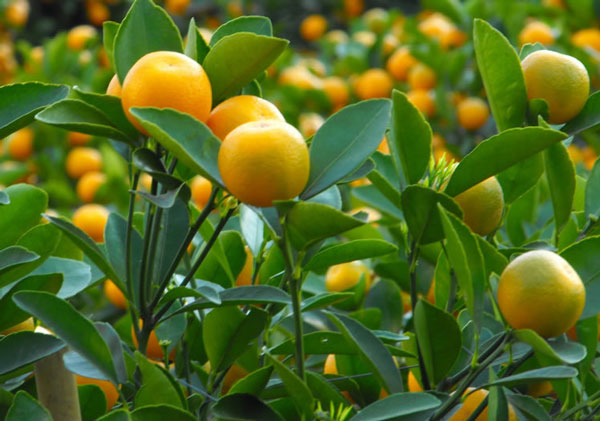How to Grow & Care for Kumquat Trees
Written by Iris
Oct 19 2021

Kumquat trees thrive in full sunlight, in 50 or 60 percent humidity, and in moist, semi-acidic soil. Kumquat trees' healthy leaf shedding is common. Use a container large enough to balance the growth of the tree. The trees may take four or five years to mature, flower and bear fruit.

Wrap kumquat seeds in a damp paper towel in early spring. Soak the paper towel in tap water and wring it out. Spread the seeds across one half of the paper towel so they aren’t touching and so they are evenly spaced from one another. Fold the paper towel so the seeds are covered.
Place the paper towel with the seeds in a resealable sandwich bag. Keep the seeds wrapped inside the towel. Squeeze all of the air out of the bag before you seal it because air left in the bag will make the paper towel and the seeds dry out and they will be less likely to germinate.
Keep the bag in a warm area for 1 week. Place the bag on a windowsill, a seedling mat, or above a heater to keep it warm. The seeds do not need direct sunlight right now, but they do need warmth and humidity.
Fill cell pots to the top with a potting mix of soil, organic matter, and sand. Kumquats need well-draining soil, so create an even mix of sand, potting soil, and compost in each cell pot. Prepare enough pots for the number of seeds that you’ve placed in the bag.
Bury 1 seed in each cell 1⁄2 in (13 mm) below the surface of the potting mix. Poke a hole into the middle of each pot with the tip of your finger or the end of a pencil. Place the germinated seed so the root is facing down and cover it with the potting mix. Press lightly so the soil is in contact with the seed.
Water the soil so it's wet to the touch. Use a watering can to gently pour the water onto the soil so you don't wash the soil off the seed. The soil should be damp to the touch, but there shouldn't be any standing water on the top of the pot. Stick your finger into the mix down to the first knuckle to feel if it's damp.
Soak the cut end of the branch in a rooting hormone for up to 5 days. Place the end of the cutting into the rooting hormone mixed with water. Follow the instructions on the packaging to make the correct hormone solution. Let the cutting absorb the hormone from the solution.
Stick the branch 1.5 in (3.8 cm) deep into a medium pot with damp soil. Make a small hole in a potting medium or equal parts soil, sand, and compost with your finger or the end of a pencil. Place the cutting in the hole you’ve made and firm up the soil so it can stand on its own.
Transplant trees in early spring or fall. The warm months of summer are peak growing seasons for kumquat trees, so wait until the cooler months if you need to move your tree. Prepare soil in a larger pot or in the ground and carefully remove the kumquat tree from its old container. Replant the tree so the top of the root ball is even with the soil and growing kumquat tree from cuttings is finished.

Many kumquat trees are grafted , when these kumquat plants are young, shoots at times will develop below the graft union. These shoots should be removed lest they commandeer the rootstock leaving the grafted kumquat small, scraggly and unproductive.
Although indoor plants are less susceptible to pests, be sure to keep an eye out for aphids, scale and mealybug infestations. Remove visible bugs and treat with an insecticide soap or horticultural oil. Controlling these pests will protect the tree from sooty mold fungus.
Kumquat trees are self-pollinating, but because indoor trees don't have butterflies and bees to help pollinate the flowers, your tree may stop producing fruits. You can help pollinate the tree by gently shaking or flicking the flowers to help spread pollen, advises the University of Minnesota Extension.
Citrus japonica 'Nagami', the most popular type of kumquat, is oval in shape and has deep-orange fruit with two to five seeds per kumquat.
Citrus japonica 'Meiwa' is larger than 'Nagami', has a sweeter pulp and juice, and is nearly seedless.
Citrus japonica 'Marumi' is round and bears orange-like fruits. All varieties grow nicely in a container.
Citrus japonica 'Centennial Variegated' is a compact form growing 7 to 10 feet tall with leaves and fruit that are both variegated.
Where to Grow Kumquat TreeWhen to Grow Kumquat TreeHow to Grow Kumquat TreeGrow Kumquat Tree from SeedsGrow Kumquat Tree from CuttingsHow to Care for Kumquat TreeKumquat Light CareKumquat Soil CareKumquat Tree WateringTemperature and Humidity CareFertilizer CarePruning Kumquat TreePests and Diseases CareVarieties of Kumquat TreeKumquat Tree FAQWhere do kumquats Trees Grow in the USA? What are the Benefits of Eating Kumquat Fruits?When Does A Kumquat Fruit?
Where to Grow Kumquat Tree
Select a location in your home that will accommodate the height and width of a kumquat and where the tree will get as much bright light as possible. If you don't have a spot where the tree gets at least six hours of sunlight, you may need to provide supplemental light to make sure the kumquat continues to flower and produce fruit.When to Grow Kumquat Tree
One of the most natural things about a kumquat tree is that they are self-pollinating, so you do not need to grow multiple trees; one will be enough. The spring is going to be the ideal time to start planting a new kumquat tree from seed, as there are higher chances of rain and lots of sunshine. Early spring is the best time when you are transplanting a sapling as well.
How to Grow Kumquat Tree
Grow Kumquat Tree from Seeds
Here are steps on how to grow Kumquat tree from seed.Wrap kumquat seeds in a damp paper towel in early spring. Soak the paper towel in tap water and wring it out. Spread the seeds across one half of the paper towel so they aren’t touching and so they are evenly spaced from one another. Fold the paper towel so the seeds are covered.
Place the paper towel with the seeds in a resealable sandwich bag. Keep the seeds wrapped inside the towel. Squeeze all of the air out of the bag before you seal it because air left in the bag will make the paper towel and the seeds dry out and they will be less likely to germinate.
Keep the bag in a warm area for 1 week. Place the bag on a windowsill, a seedling mat, or above a heater to keep it warm. The seeds do not need direct sunlight right now, but they do need warmth and humidity.
Fill cell pots to the top with a potting mix of soil, organic matter, and sand. Kumquats need well-draining soil, so create an even mix of sand, potting soil, and compost in each cell pot. Prepare enough pots for the number of seeds that you’ve placed in the bag.
Bury 1 seed in each cell 1⁄2 in (13 mm) below the surface of the potting mix. Poke a hole into the middle of each pot with the tip of your finger or the end of a pencil. Place the germinated seed so the root is facing down and cover it with the potting mix. Press lightly so the soil is in contact with the seed.
Water the soil so it's wet to the touch. Use a watering can to gently pour the water onto the soil so you don't wash the soil off the seed. The soil should be damp to the touch, but there shouldn't be any standing water on the top of the pot. Stick your finger into the mix down to the first knuckle to feel if it's damp.
Grow Kumquat Tree from Cuttings
Cut a 4 in (10 cm) branch from a kumquat tree with at least 3 nodes in the spring. Use a sharp and clean gardening knife or a saw to remove a branch from a kumquat tree. Make your cut at a 45-degree angle to prevent the tree from getting any diseases. Ensure your cutting has 3 nodes, the knobby areas on the stem where the leaves grow.Soak the cut end of the branch in a rooting hormone for up to 5 days. Place the end of the cutting into the rooting hormone mixed with water. Follow the instructions on the packaging to make the correct hormone solution. Let the cutting absorb the hormone from the solution.
Stick the branch 1.5 in (3.8 cm) deep into a medium pot with damp soil. Make a small hole in a potting medium or equal parts soil, sand, and compost with your finger or the end of a pencil. Place the cutting in the hole you’ve made and firm up the soil so it can stand on its own.
Transplant trees in early spring or fall. The warm months of summer are peak growing seasons for kumquat trees, so wait until the cooler months if you need to move your tree. Prepare soil in a larger pot or in the ground and carefully remove the kumquat tree from its old container. Replant the tree so the top of the root ball is even with the soil and growing kumquat tree from cuttings is finished.

How to Care for Kumquat Tree
Kumquat Light Care
Kumquat trees need as much direct sun as possible to produce flowers and fruit. Give it a quarter turn every week to expose each side to sunlight. You can move it outdoors during the warm months to give it a boost.Kumquat Soil Care
A slightly acidic potting mix will work. A better option is a mix prepared specifically for citrus trees. Avoid alkaline soils and hard water, indicated if your tree’s leaves become light green with dark green veins. In this case, you can use a soil acidifier to correct the problem.Kumquat Tree Watering
You should water the kumquat regularly. Before you water them, you should check whether the soil is moist. If the soil is moist, you should not water the tree, as excess water will lead to infections in the roots. It is easy to figure out when to water this citrus tree. Insert your finger in the soil till it goes 1 inch deep. If you find that the soil is dry, then water it, else wait for a few days. Generally the only surface of the soil gets dried up, and the layer of the soil below the surface remains moist. If you water the plant by just observing the surface of the soil, you might end up providing the kumquat more water than it needs, and this will not be beneficial for it. By inserting your finger in the soil, you can understand the moisture content of the soil in a better way.
Temperature and Humidity Care
Try to maintain at least 40% relative humidity around your plant. Use a cool-mist room humidifier near the plant. Average room temperatures 65-75°F/18-24°C are ideal year-round. This citrus tree will tolerate a minimum of 50°F/10°C in winter.Fertilizer Care
Do not fertilize the baby kumquat tree till it is several months old, once you start fertilizing, do so in moderation. Kumquats like all citrus trees are heavy feeders and will benefit from a moderately nitrogen rich soil but also require micro nutrients and trace minerals – managanese and magnesium, iron, copper, boron and zinc. Once the tree is established fertilizer should be applied in moderation every other month. Foliar sprays or conventional soil fertilizer will suffice, but it is best that if you use a commercial blend that is designed specifically for citrus trees. Reduce or do not apply fertilizer in late fall when winter is approaching.Pruning Kumquat Tree
As a young plant it is a good idea to pinch back the new growth tips and soft shoots which will lead to a fuller and bushier tree. Pruning kumquat tree is only necessary to remove dead branches and suckers or to train the tree to a desired shape or height. If pruning for shape or height it is best to wait till after the harvest. Older plants may need to be pruned only to maintain shape and this is best done after fruiting.Many kumquat trees are grafted , when these kumquat plants are young, shoots at times will develop below the graft union. These shoots should be removed lest they commandeer the rootstock leaving the grafted kumquat small, scraggly and unproductive.
Pests and Diseases Care
Kumquats are prone to root rot if the soil is too soggy. Be sure to empty the tray under the pot after watering so that the soil is not soggy. Indoor citrus is also prone to sooty mold fungus, an organism that feeds on the honeydew of certain insects.Although indoor plants are less susceptible to pests, be sure to keep an eye out for aphids, scale and mealybug infestations. Remove visible bugs and treat with an insecticide soap or horticultural oil. Controlling these pests will protect the tree from sooty mold fungus.
Kumquat trees are self-pollinating, but because indoor trees don't have butterflies and bees to help pollinate the flowers, your tree may stop producing fruits. You can help pollinate the tree by gently shaking or flicking the flowers to help spread pollen, advises the University of Minnesota Extension.

Varieties of Kumquat Tree
Kumquat trees are produced by grafting fruit-bearing branches onto the rootstock of oranges and grapefruits. If kumquat seeds are planted, they will not produce viable trees.Citrus japonica 'Nagami', the most popular type of kumquat, is oval in shape and has deep-orange fruit with two to five seeds per kumquat.
Citrus japonica 'Meiwa' is larger than 'Nagami', has a sweeter pulp and juice, and is nearly seedless.
Citrus japonica 'Marumi' is round and bears orange-like fruits. All varieties grow nicely in a container.
Citrus japonica 'Centennial Variegated' is a compact form growing 7 to 10 feet tall with leaves and fruit that are both variegated.
Kumquat Tree FAQ
Where do kumquats Trees Grow in the USA?
Kumquat trees are most often grown in Florida and California.What are the Benefits of Eating Kumquat Fruits?
Kumquat fruits are incredibly high in vitamin C and fiber. Eating them can help strengthen the immune system and support weight loss.When Does A Kumquat Fruit?
Depending on the variety, harvest time for kumquat fruit is winter through early spring. Flowering occurs in summer, followed by fruit set in autumn and ripening in winter.Latest Updated
- Benefits of Bugleweed - 7 Science-backed Health Benefits
- Bugleweed Dangers & Side Effects - Is It Poisonous?
- How to Plant Evergreen Trees - What You Should Know
- When to Plant Evergreens - Grow Guide for Evergreen Trees
- 12 Wonderful Evergreen Shrubs for Your Garden
- 12 Popular Evergreen Plants with Pictures for Beginners
- When And How To Prune A Lilac Bush Like a Pro
- How to Grow & Care for Lilac Vine (Hardenbergia Violacea)
- Japanese Lilac Tree (Syringa Reticulata) Care & Propagation Guide
- Shumard Oak Pros and Cons - What to Know
Popular Articles
- Winter maintenance of Antirrhinum Majus
- How to Grow Terminalia Mantaly Tree
- How to Grow and Care for Crossostephium Chinense
- How to grow Antirrhinum Majus in spring
- Peristeria Elata (Dove Orchid) Profile: Info & Care Guide
- Underwatered Snake Plant (Sansevieria Trifasciata) - Signs And How To Fix
- How to Care for Brazilian Jasmine Plant (Mandevilla Sanderi)
- How to Grow & Care for Graptopetalum Purple Delight in Summer
- Rosa Chinensis (China Rose): Plant Growing & Care Tips
- How to Care for Baby Sun Rose (Aptenia Cordifolia)
